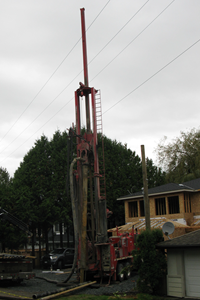Worker seriously injured when drilling rig contacted power line
Date of incident: October 2020
Notice of incident number: 2020188280022
Employer: Well-drilling firm
Incident summary
A worker and his supervisor attended a residential construction site to drill a water well. The ground was too soft to drive the drilling rig onto the site, so the well-drilling firm asked the property owner to place gravel on the ground in the area in which the drilling rig was to be set up. A few days later, the workers returned to drill the well and found that the site had not been cleared sufficiently and the gravel had not been placed in the specified location, so the well would have to be drilled in a different location. The supervisor drove the rig onto the gravel and raised the mast of the rig. While the two workers were setting up the drilling equipment, part of the drilling rig contacted a conductor on an overhead power line. One of the workers, who was on the ground holding a hose connected to the drilling rig, sustained serious electrical injuries.
Investigation conclusions
Cause
- Drilling rig contacted power line. The drilling rig was being set up within the limits of approach to an overhead power line. A hydraulic line on a gearbox attached to the mast of the rig contacted one of the conductors on the power line.
Contributing factors
- Inadequate hazard identification and risk mitigation. The employer did not require any formal hazard assessment when the work was initially planned, and no hazard identification or risk assessment was documented when the well location was selected. Pre-work documentation did not provide a precise location for the well, so it was not possible to ascertain whether the originally intended location for the well would have been far enough away from the power line to keep all the equipment outside of the limits of approach. A written field-level hazard assessment was required but was not completed. The workers were not able to drill at the originally intended spot on the property, making a hazard assessment particularly important as the work plan had changed.
- Inadequate work planning and communication. The work plan relied on a photograph of the site with handwritten markings to identify the location at which the well was to be drilled and where on the property the drilling rig was to be placed. Because of the way the worksite was set up, the placement of the drilling rig and the location where the well was to be dug were changed. The employer had no clear process in place for managing changes to the work plan. The lack of a detailed work plan and clear process for changing the work plan contributed to poor communication and unsafe work activities taking place.
- Inadequate supervision. The employer did not adequately oversee the work. The employer required its workers to carry out a field-level hazard assessment for each job and submit documentation of the assessment, but the employer had not been collecting the documentation.
- Inadequate training. Although the employer had provided training on operating the drilling rig and on its health and safety management plan in the past, there is no evidence that the employer took steps to ensure that workers had fully understood and were following the plan. The employer also did not provide any training specific to the role of supervising other workers. In addition, the employer did not ensure that all workers were provided with a new worker orientation and that they were trained on the health and safety management plan.

